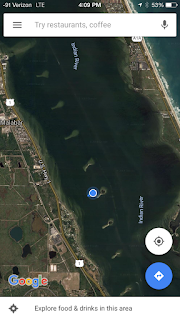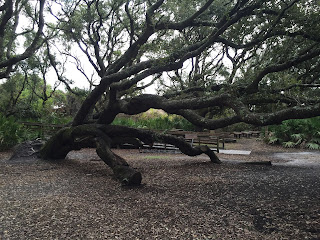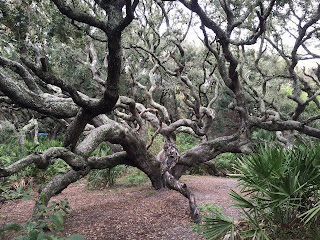922 nm
N29 53.516 W081 18.566
Warning. Long post, covers 3 days.
Since its only a short 12 NM from Pine Island to St. Augustine, we were able to sleep a little later this morning and left about 8am. The trip was quick and easy. Even crossing the inlet was calm. In no time we were passing the San Marcos fort and approaching the Bridge of Lions.
 |
| Castillo de San Marcos |
After we radioed in, we tied up up at their fuel dock to top off our tank, and then transferred to our slip.
 |
| On the Dock at St. Augustine |
We initially paid for two nights, but later decided to extend it to 3 nights. St. Augustine is one of our favorite stops on the ICW. The marina is right in the middle of town, and everything is within walking distance. A friend of ours once stopped here for overnight, and ended up staying 4 months!
Pearl took a mooring ball for 3 days, with the possibility of staying longer if there was room. Once everybody was settled in, they dinghyed ashore and we set out walking.
Our first two stops were to be the "Booze Tour", successive tours of the
San Sebastian Winery (free samples!) followed by the
St. Augustine Distillery (more free samples!). Both were quite generous in their samples, and we were glad we were walking, not driving, afterwards!
 |
| Upstairs Catwalk as San Sebastian |
 |
| One of the Tasting Rooms |
The winery tour was self guided, with multiple tasting stops for a total of about ten different wines. The Distillery tour was led by a "Spirit Guide", who gave us a presentation on the history of the distillery, which was built in a preserved 1907 Ice House, followed by tours and explainations of the stills and the aging rooms. Although their focus is Bourbon, they also do Gin, Rum, and Vodka. all in small batches. The sampling bars went through a number of mixers (Old Fashoned, Florida Mule, etc) followed by a trip upstairs to the "neat" bar for shots of any and all of their spirits.
A thoroughly enjoyable afternoon!
 |
| Stills |
 |
| Aging Room |
Afterwards, we hiked over to St. George Street. This has been closed to car traffic and turned into a pedestrian walkway that goes on for about half a mile. It's very tourist trappy, but still a lot of fun to walk and people-watch. We stopped for lunch at a place that is reputed to have the best pizza in the country, and the line out the door seemed to agree. A nearby pizza place across the street was virtually empty. I thought the pizza was good, but not particularly outstanding. Superior marketing, I guess.
By blind luck, and for the second time, our stay here coincided with the lighting ceremony for the "Festival of Lights". The downtown park has over 1 million lights strung through the trees, bushes and palms, and they have a big party with live music, and a countdown to light it all up at once. The city is already lit up with white lights outlining most of the buildings, and this just puts it over the top,
Before the lighting, on the recommendation of a local, we hiked out to the center of the Bridge of Lions to get a view of the city from higher up.
 |
| View from the Bridge of Lions |
 |
| ...three, two, one, ... Lights! |
The next day, we hiked around, enjoying the waterfront views and getting a few errands done.
 |
| North of the Bridge |
 |
| Panorama of the North Mooring Field |
|
I'm always interested in the specifics of the architecture of these old towns. One of the things I learned here is that there is no clay to make bricks, so early spanish settlers used someting called "tabby". Tabby is a type of concrete made by burning oyster shells to create lime, then mixing it with water, sand, ash and broken shells. Tabby was used like concrete for floors, foundations, columns, roofs or was made into bricks. When used for buildings, its often coated with white stucco. A naturally occuring version of this, a sedementary rock called Coquina, was mined in blocks and used to construct the San Marcos fort.
 |
| A Tabby Wall on St. George Street |
Joan had discovered that an old friend of hers from Laurel was now living in St. Augustine and was just ten minutes from downtown. We arranged to meet them for happy hour & dinner at a nearby brewpub called A1A Ale Works. The food and company were both great.
 |
| Joan, Terry, and her husband Ed |
On our last day in St. Augustine, we got together with Bruce & Gayleen in the morning. Since no trip to St Augustine is complete without a visit to the
Sailor's Exchange, we split up, with the men going to gawk at boat hardware and the women off to various thrift stores.
 |
| Sailor's Exchange |
 |
| Used Boat Bits |
It reminded me of a larger version of Bacon's in Annapolis.
After we reuinted with the women, we did a short tour of the outer grounds of Flager College. The centerpiece of the campus is the former
Ponce de León Hotel, a luxury hotel built in 1888.
In the late afternoon, we briefly met up with Sean and Eva from S/V Emerald Fire, now tied to a mooring. We invited them to join us for happy hour, but they politely declined, saying thay had patried a lot the night before, and were going to turn in early tonight.
We ended up returning to A1A Ale Works with Bruce and Gayleen. They had been unable to extend their mooring for even one more night, so they would be moving on in the morning too. We spent another pleasant evening relaxing with good food and good friends.
Life is really good.



















































